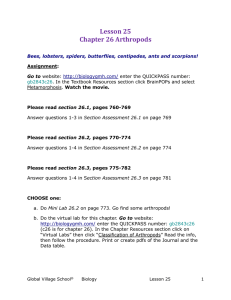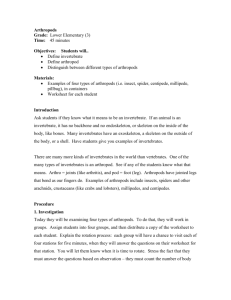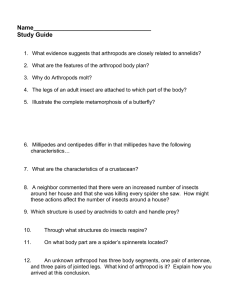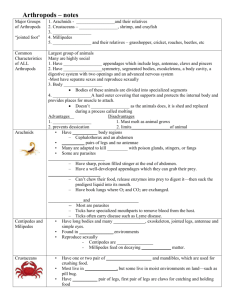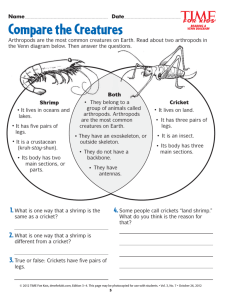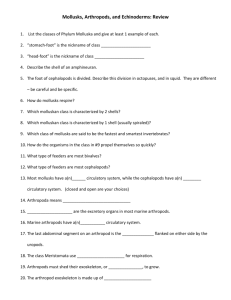AMAZING ARTHROPODS A : A
advertisement
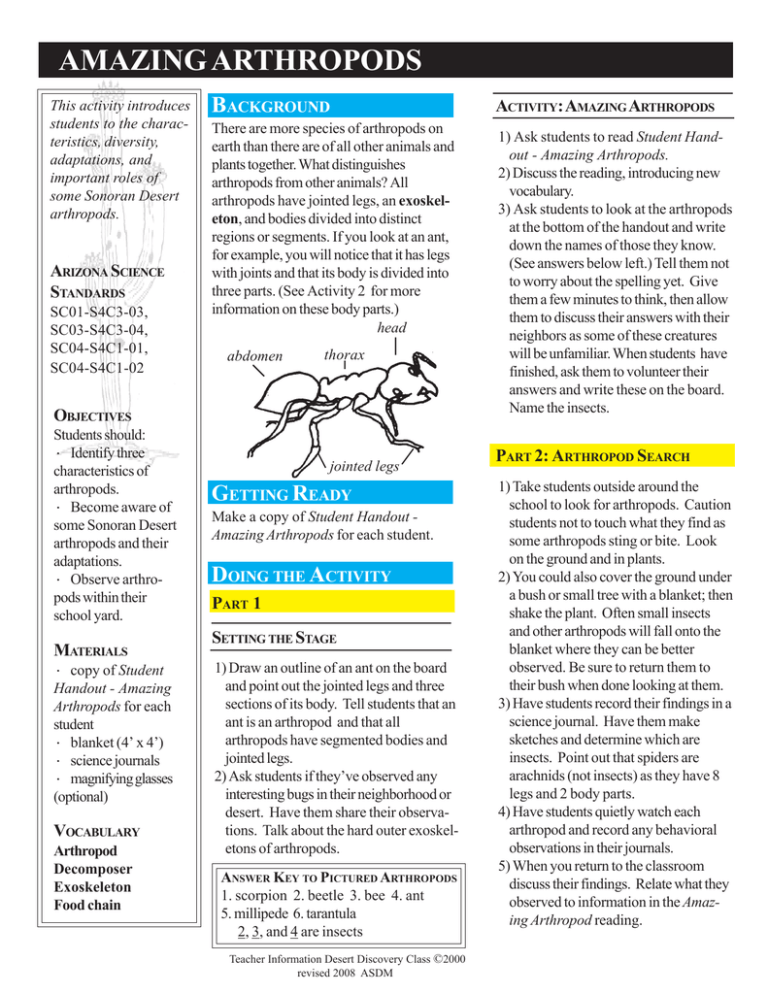
AMAZING ARTHROPODS This activity introduces students to the characteristics, diversity, adaptations, and important roles of some Sonoran Desert arthropods. ARIZONA SCIENCE STANDARDS SC01-S4C3-03, SC03-S4C3-04, SC04-S4C1-01, SC04-S4C1-02 BACKGROUND There are more species of arthropods on earth than there are of all other animals and plants together. What distinguishes arthropods from other animals? All arthropods have jointed legs, an exoskeleton, and bodies divided into distinct regions or segments. If you look at an ant, for example, you will notice that it has legs with joints and that its body is divided into three parts. (See Activity 2 for more information on these body parts.) head abdomen thorax OBJECTIVES Students should: · Identify three characteristics of arthropods. · Become aware of some Sonoran Desert arthropods and their adaptations. · Observe arthropods within their school yard. MATERIALS · copy of Student Handout - Amazing Arthropods for each student · blanket (4’ x 4’) · science journals · magnifying glasses (optional) VOCABULARY Arthropod Decomposer Exoskeleton Food chain jointed legs GETTING READY Make a copy of Student Handout Amazing Arthropods for each student. DOING THE ACTIVITY PART 1 SETTING THE STAGE 1) Draw an outline of an ant on the board and point out the jointed legs and three sections of its body. Tell students that an ant is an arthropod and that all arthropods have segmented bodies and jointed legs. 2) Ask students if they’ve observed any interesting bugs in their neighborhood or desert. Have them share their observations. Talk about the hard outer exoskeletons of arthropods. ANSWER KEY TO PICTURED ARTHROPODS 1. scorpion 2. beetle 3. bee 4. ant 5. millipede 6. tarantula 2, 3, and 4 are insects Teacher Information Desert Discovery Class ©2000 revised 2008 ASDM ACTIVITY: AMAZING ARTHROPODS 1) Ask students to read Student Handout - Amazing Arthropods. 2) Discuss the reading, introducing new vocabulary. 3) Ask students to look at the arthropods at the bottom of the handout and write down the names of those they know. (See answers below left.) Tell them not to worry about the spelling yet. Give them a few minutes to think, then allow them to discuss their answers with their neighbors as some of these creatures will be unfamiliar. When students have finished, ask them to volunteer their answers and write these on the board. Name the insects. PART 2: ARTHROPOD SEARCH 1) Take students outside around the school to look for arthropods. Caution students not to touch what they find as some arthropods sting or bite. Look on the ground and in plants. 2) You could also cover the ground under a bush or small tree with a blanket; then shake the plant. Often small insects and other arthropods will fall onto the blanket where they can be better observed. Be sure to return them to their bush when done looking at them. 3) Have students record their findings in a science journal. Have them make sketches and determine which are insects. Point out that spiders are arachnids (not insects) as they have 8 legs and 2 body parts. 4) Have students quietly watch each arthropod and record any behavioral observations in their journals. 5) When you return to the classroom discuss their findings. Relate what they observed to information in the Amazing Arthropod reading. NAME______________________________ STUDENT HANDOUT Amazing Arthropods 2 body segments They have lived on Earth for millions of years, long before the dinosaurs. They live in almost every habitat in the world, even the Antarctic. There are more species of arthropods on earth than there are of all other animals and plants put together! What are these creatures we call arthropods? Tarantulas, Pinacate beetles, harvester ants, gnats, bees, centipedes, butterflies, scorpions, fairy shrimp and water striders are some examples of the 15,000 species of arthropods found in the Sonoran Desert Region. Arthropods do not have bones inside their bodies as we do. Instead they have a hard outer covering called an exoskeleton. They also have jointed legs and their bodies are divided into parts called segments. Sometimes, it’s hard to like these creepy crawlies. That’s because most people don’t know much about them. They think arthropods do only “bad” things—like sting, spread disease, destroy plants, and even come uninvited to picnics. But arthropods do many “good” things too. They pollinate plants, provide food for birds, fish and other animals, and jointed legs eat other pesky insects. They are an important part of the food chain. Some insects, like termites and millipedes, are decomposers. Decomposers eat dead plants and animals, recycling nutrients into the soil that plants need to grow. And some are “good” just because they are pretty and have very interesting lives. Arthropods have many adaptations that help them live in the desert. Their exoskeletons are covered with a tough, waxy coating that keeps them from drying out. Since they are small, it is easy for them to find enough shade to keep cool. Some arthropods, including scorpions, tarantulas and June beetles, are most active during the summer nights. Others, such as ants, avoid the heat and cold by staying underground. As the cool, fall weather approaches, many adult insects lay eggs and die. The young larvae hatch the following spring when it warms up and there are fresh leaves to eat. Can you name the arthropods below? Circle the insects (hint: insects have 6 legs) 1 2 3 6 4 5 Teacher Information Desert Discovery Class ©2000 revised 2008 ASDM
